How to launch digital products that sell off the (virtual) shelves
You did it. You finished creating your digital product. 🥳
We know how much brainpower, caffeine, and possibly a minor identity crisis went into this thing.
But now comes the million-dollar question: will you make money from it?
We’re not going to sugarcoat it. No matter how brilliant your idea is, it won’t launch itself (after all, it’s not a self-driving car. And even those have been known to explode.) If you have a digital product to sell, you need a solid launch plan, a marketing strategy, and a focused sales approach to back it up.
Not sure where to start? This guide will help you:
- Choose the right platforms and tools to sell your digital product
- Craft a launch and marketing strategy that drives revenue
- Get inspired by real-world examples from successful Circle creators
Let’s begin! 💪
Where should you sell your digital product?
Marketplace vs. self-hosted platforms
Deciding where you should sell digital products is probably one of the most important considerations when launching. You have two choices—sell it via a marketplace or self-hosted platforms.
- Digital marketplaces are third-party platforms where you can list and sell your product alongside thousands of others.
- Self-hosted platforms, on the other hand, give you full control over how your product is sold, delivered, and experienced.
Let’s see how they fare against each other in the table below👇
| Criteria | Marketplace | Self-hosted platforms |
|---|---|---|
| Setup time and tech skills | Fast setup with minimal technical effort | Requires more setup and platform customization |
| Audience | Some organic visibility through the platform, but requires optimized listings and additional marketing efforts | You must generate your own traffic through marketing efforts |
| Branding | Limited; product pages follow platform templates | Full brand control across landing pages, content, and user experience |
| Customer data ownership | Somewhat restricted, depending on platform | Full access to all customer data and communication channels |
| Pricing flexibility | Set within platform rules; some restrictions on minimums or bundles | Total control over pricing models, offers, and discounts |
| Fee structure | Typically includes transaction fees, listing fees, or platform commissions | Usually just payment processor fees (e.g., Stripe); some platforms have a subscription fee |
| Sales and upsell potential | Dependent on platform flexibility, but usually quite limited | Full control over ability to create funnels, bundles, subscriptions, and memberships |
| Content hosting | Often limited to simple files or downloads | Can host full courses, communities, drip content, and more |
| SEO and discoverability | Platform SEO may help products get discovered | You control your SEO, but you have to invest in it in order for it to make an impact |
| Support expectations | Buyers expect limited interaction | Buyers may expect onboarding, updates, or direct support |
| Long-term scalability | More limiting; harder to grow into a brand | Highly scalable; ideal for creators building a full digital business |
| Best for | Beginners testing ideas, casual sellers, or low-cost downloads | Solopreneurs building a brand, community, or recurring revenue stream |
Popular platform options
Marketplaces:
- Gumroad: Best for selling low-friction digital products like PDFs, templates, or eBooks.
- Etsy: Ideal for creative products like art prints, digital planners, or craft patterns.
- Creative Market: Built for designers selling fonts, templates, or visual assets.
- Ko-fi: Great for creators offering pay-what-you-want downloads, zines, or bonus content.
- Notion: Best for Notion template creators and sellers who want to reach users directly within Notion’s website.
- ThemeForest: Best for creators who build and sell website themes for platforms like WordPress, Elementor, or Shopify.
- ArtStation: Designed for selling digital art, illustrations, concept work, and other creative assets.
Self-hosted platforms:
- Circle: Best for creators bundling community, content, and digital products in one branded hub.
- Teachable: Built for educators who want to host structured online courses with upsell options.
- Shopify (with digital plugins): Ideal for creators who want to focus on digital products.
Which option you go for, though, will depend on what you’re selling and which features are non-negotiable for you.
Technical considerations
If you're just getting started, marketplaces are the easiest way to launch. You can usually sign up, upload your product, set a price, and start selling—all without writing code, building a website, or connecting a bunch of tools.
🔃 The tradeoff? Simplicity comes with limitations. You won’t have much control over the buyer experience, you’re stuck with whatever customization options the platform offers, and your product lives on their domain—not yours.
On the other hand, self-hosted platforms require a bit more upfront effort. You’ll need to set up your own landing pages, manage access to your product, and figure out how delivery will work. It’s not overly technical, but there is a learning curve.
That said, the extra control can be worth it. If you want to fine-tune your sales process, fully brand the customer experience, or scale beyond a single product, self-hosting gives you the flexibility to grow.
Setting up your sales system
One thing’s for sure: your sales system needs to do three things really well:
- Collect payments
- Deliver the product
- Support your customers
Payment processing
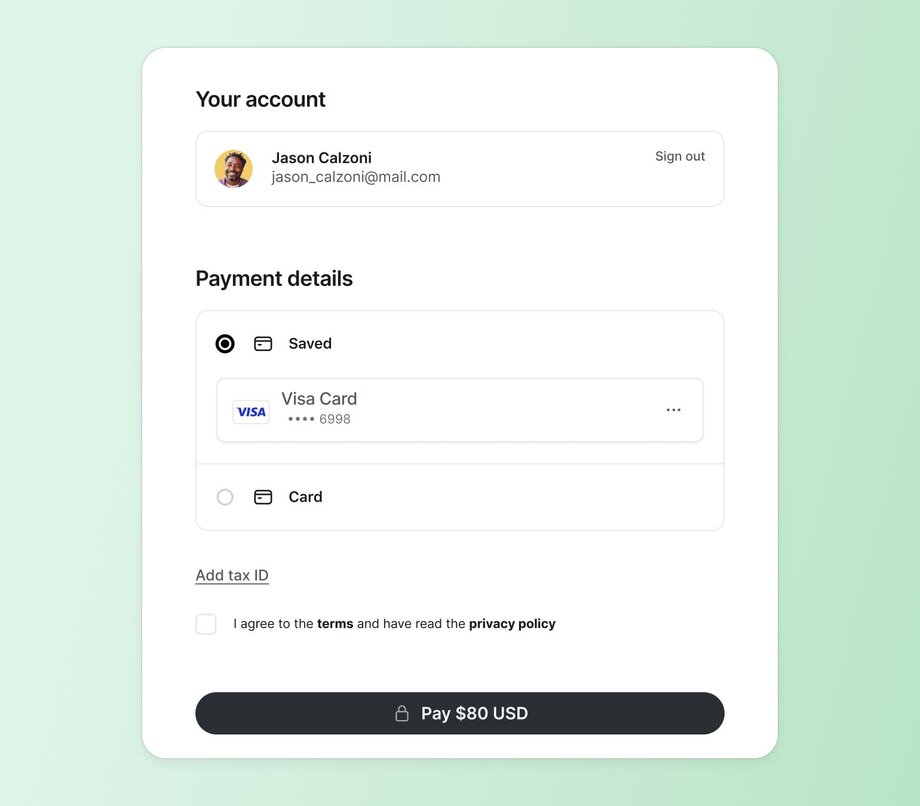
Most marketplaces and self-hosted platforms offer integrations with Stripe and PayPal, making it simple to accept payments globally. But you also need to consider what kind of digital product you’ll be selling and how you’ll charge your customers.
- Will you be offering one-time products?
- Monthly subscriptions?
- Different tiers?
For example, with Circle’s Paywalls, you can monetize your digital products and content through flexible options:
- Recurring subscriptions (daily to annual)
- One-time fees (limited access)
- Installment plans (split payments over time)
You can also gate specific content, spaces, or even your whole community—perfect if you’re offering courses, digital downloads, or exclusive group access. Circle also integrates with Stripe to handle payments in dozens of currencies (from AED to ZAR), and supports modern payment methods like Apple Pay, Google Pay, and even Buy Now, Pay Later for added flexibility.
Automated delivery
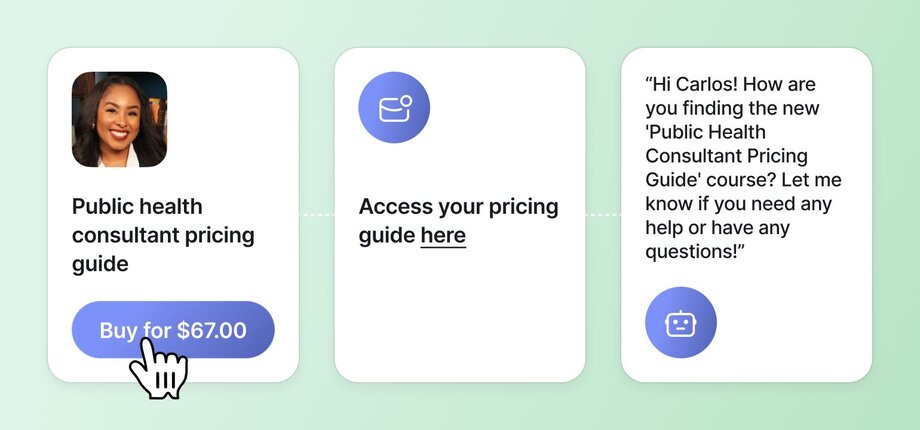
The moment someone buys, they should receive what they paid for. This could be as simple as an automated email with a download link or as advanced as unlocking a course or community space.
This is where Circle’s Workflows shine, and turn multi-step processes (like enrollment or product delivery) into a pleasant, easy-to-manage cakewalk. 🎂
Remember, the fewer manual steps your buyers need to take after a sale, the better their experience, and the easier it becomes to scale your business.
Customer support
Even for digital products, buyers might have access issues, questions, or refund requests. A basic support system—like a FAQ, a help form, chatbot, or a pinned community thread—goes a long way in keeping your customers happy (and reducing refund requests or negative reviews).
But most importantly, it should be easy to use for customers and for you. Which is only one of the reasons we added personalized AI Agents to our lineup—to help you scale without (necessarily) hiring a support team, or needing to add a customer support tool to your expenses.
Legal considerations (yes, you need to think about these)
Selling digital products comes with responsibilities, and skipping the legal setup can put both you and your customers at risk. A few key policies can go a long way in protecting your business and building trust:
- Terms of service: Outline exactly what buyers are getting, how your product can be used, and refund policies.
- Copyright notice: Claim ownership of your work across all assets (PDFs, videos, slides). This gives you legal ground if someone copies or redistributes your product.
- Privacy policy: Required if you collect emails or payment info. Be transparent about how you store and use customer data.
- GDPR compliance: If you sell to EU-based customers—which, as a global, online business, it’s likely you do or will at some point—you must follow data protection rules. Here’s a quick overview.
Marketing your digital products like a seasoned pro
Now that we’ve covered the basics, let’s go over a few simple strategies to help you market and promote your product effectively.
Nail these three things first
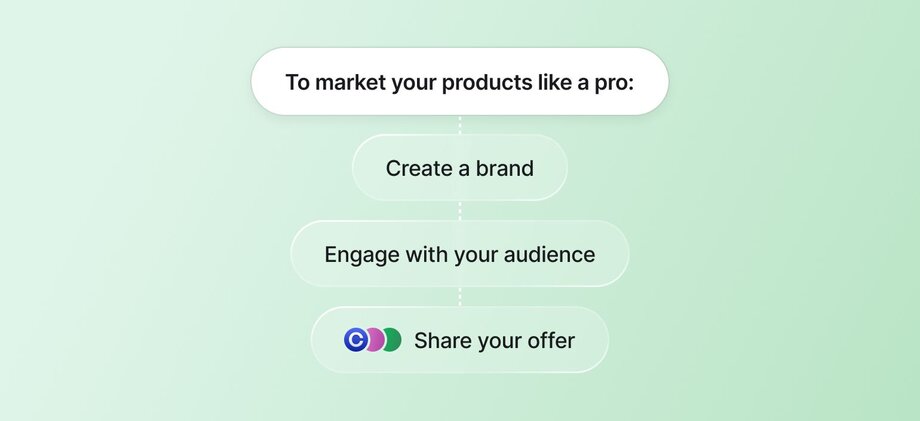
Behind every successful digital product? These three things show up again and again:
👉 A brand. Your brand is your reputation in shorthand. It tells people what you do, who you serve, and why they should care—all before they’ve even clicked. If that’s unclear or inconsistent, nobody is going to buy from you. Not sure where to begin? Learn how Maya Elious built a $4 million coaching business by mastering the power of branding.
👉 An audience. Who’s going to buy your product? Ideally, you created it after doing audience research—talking to your people, testing ideas, and validating demand. No audience yet? Focus first on building credibility and connection before making the ask. Or check out how one creator built a $5M business through audience-first content for some real-world inspiration.
👉 A distribution platform: A digital product can’t sell if no one sees it. Whether it’s through a marketplace, your website, a newsletter, social media, or paid ads, you need a reliable way to get your product in front of the right people. Start with the channels you already have, then grow from there. The goal isn’t to be everywhere—it’s to be effective where it counts.
Create your digital product marketing strategy

Okay, so when it comes to marketing your digital product, you’ll want to mix and match a few of the ideas below.
Content marketing and SEO
Content is one of the most effective (and sustainable) ways to market your digital products, especially if you want to reach people who don’t know you yet.
When we say content, we’re talking about things like:
- Blog posts on your website
- Step-by-step tutorials or guides
- YouTube videos
- Podcasts
In order to make sure your effort doesn’t go to waste, make sure to optimize your content for search engines. SEO, or Search Engine Optimization, is a strategy meant to increase your visibility on Google’s search results page for important keywords your ideal customers may use to find your business.
For example: Ali Abdaal, an ex-doctor turned YouTuber and entrepreneur, might want to drive traffic to his digital course, the Part-Time Youtube Academy, by targeting keywords like “YouTuber academy” or “YouTube course.” Similarly, Elsynergy—a community for female entrepreneurs focused on automation and high-ticket coaching—might aim to rank for terms like “business coaching for women” or “passive income course.”
Done well, SEO brings in organic traffic. And some of that traffic? It turns into email subscribers. Then, with the right follow-up, some of those subscribers become customers. That’s a very basic funnel, but you get the idea.
Take Julie Solomon, a personal branding expert and business coach with a multi-7-figure business. She built a powerful offer flywheel through content strategy that connects every piece of her business, from low-ticket digital products to high-ticket coaching. One of her $49 evergreen offers, a mini-course called Instantly Influence, generated over $53,000 and brought in 4,000+ new email subscribers in a single year.
How? Because she used content, like podcasts, blog posts, and trainings, as entry points that led people into her ecosystem. These pieces didn’t just educate—they nudged people toward offers that solved their next problem. And because they were evergreen, she didn’t need to recreate them every week. They worked on autopilot.
Social media strategies
If you already have an audience on social media, that’s one of your best channels for promoting a digital product. Why? Because your followers already know who you are. They’ve seen and liked your work, engaged with your content, and—most importantly—trust you.
Marketers call this the Know-Like-Trust factor that builds familiarity and makes it easier to offer your product in a way that feels organic, not salesy.
Promoting your product is a whole lot easier when you already have an audience. But if you're starting from scratch, Pete Boyle, founder of Growth Models, shared a clever partnership workaround that can help:
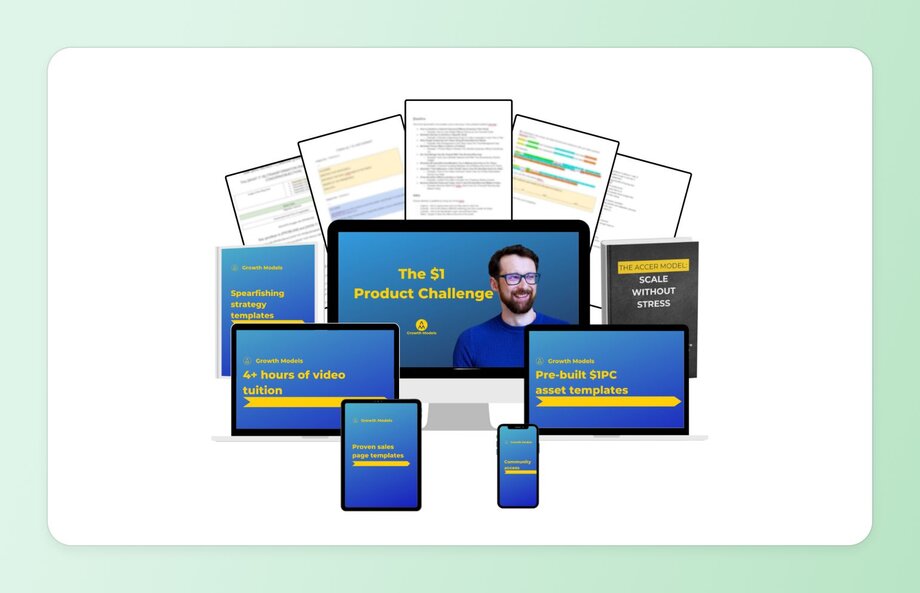
Instead of relying on a big following, Pete tapped into other people’s audiences—specifically, active Facebook groups where his ideal customers were already spending time.
He created a $1 digital product (a bundle of custom GPTs for marketers), then posted about it in four carefully chosen Facebook groups. His promotion strategy was simple but consistent: just 20 minutes a day writing value-first posts that helped others and gently introduced his product. This scrappy, organic approach turned out to be more effective than paid ads for early traction—though Pete later began testing ads once he had proof of concept.
In just 10 days, Pete made $4,069 in revenue through upsells and consulting gigs—and added new members to his community along the way.
Email marketing
Email marketing is probably the most powerful tool in your marketing toolkit. According to the Circle’s 2025 Community Trends report, 67% of creators are using newsletters to grow their business, and more than half say it drives real business results.
Your email list is where trust is built and buyers are built, one piece of great advice or point of connection after another. It’s also an asset you own, unlike your Instagram following.
TLDR: Send value-packed content, tell stories, and make offers to your list regularly.
💡 Don’t have an email list yet? Consider paying to be featured in a popular newsletter within your niche—it’s a great way to gain extra exposure and reach a targeted audience.
Paid advertising
If you have some budget to work with, paid ads can help you get in front of new audiences fast.
Platforms like Meta (Facebook & Instagram), LinkedIn, and Google let you target your ideal customer based on interests, job titles, search behavior, or even whether they’ve visited your site before.
That said, don’t run ads straight to your product right at the beginning. Why? Because most people who see your ad won’t know who you are yet. And it’s hard to convince cold traffic to buy from a brand they’ve just discovered. It’s like proposing on the first date!
Instead, start by promoting a free lead magnet like a guide or a workbook that gets people onto your email list. Then, use email marketing to build trust and eventually pitch your paid offer.
Influencer and affiliate marketing
Another way to promote? Borrow someone else’s audience! Partner with creators who already have your ideal customer’s attention, especially micro-influencers with tight-knit communities. Or, set up an affiliate program where your product users can earn a commission by sharing your product.
Take a cue from online marketing expert Amy Porterfield, who’s built a $100M business in part thanks to a powerhouse affiliate strategy. Her flagship course, Digital Course Academy, is promoted by a network of past students and partners who earn commission, helping her reach new audiences at scale.
Decide on your launch strategy
When it’s time to launch your product, how you do it also matters.
→ Build pre-launch buzz
Don’t wait until launch day to start talking about your product. Drop hints, share behind-the-scenes content, or run a waitlist—anything that builds curiosity and anticipation. Many creators use teaser posts or launch countdowns inside their communities or social feeds to create buzz, similar to how Lizzie Davey, a freelance writer and creator of several digital products, did it.
Lizzie uses LinkedIn to share her experiences as a freelancer, offer valuable tips, and take her audience behind the scenes of her product development. In one recent post, she built anticipation for version two of Workflow Wizard (her popular Notion workspace packed with templates to help freelance writers stay organized) by explaining why she created it, how it’s helped her manage client work, and why it’s become her most popular product.
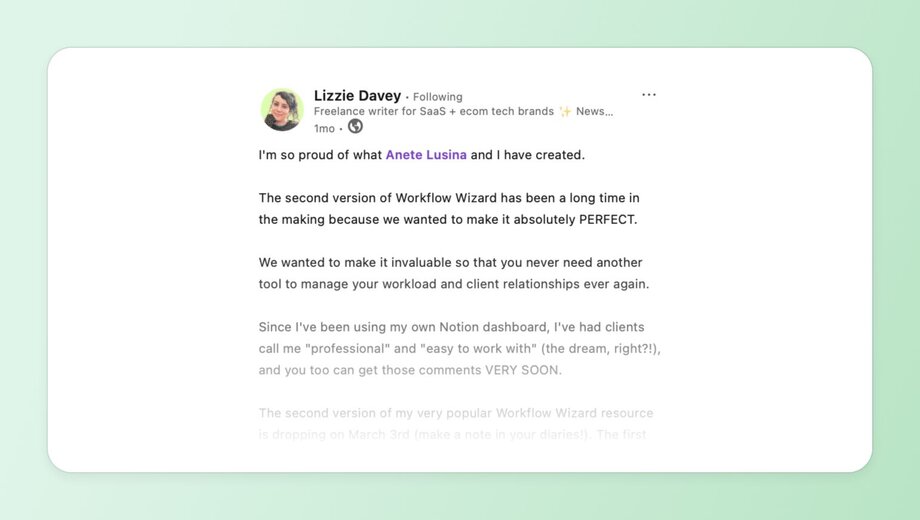
She shared that over 100 people purchased the first version in its first week. And rather than simply dropping a sales link, she encouraged her audience to join the waitlist instead.
→ Think about pricing psychology
How you price tells a story—so to make sure your goals have a happy ending, think about your goals:
- Want fast sales? Try an early-bird discount to reward your day-ones.
- Want to position your offer as high-value? Skip the discounts and price it premium, especially if your product offers a transformation or teaches a high-value skill.
| Strategy | Best for | Risk |
|---|---|---|
| Early-bird pricing | Fast sales, FOMO, engagement | Might anchor your product as “cheap” if the full price feels like a jump |
| Premium positioning | Establishing authority and attracting high-intent buyers | Slower sales upfront, may need extra effort to prove the value |
| Waitlist with perks | Growing your list before launch, warming up leads | Risk of losing steam if you don’t follow up fast or often enough before launch |
Post-purchase experience and customer journey after the launch
If you launched and got your first sales rolling in, you’re definitely on the right track. But your work doesn’t stop here.
To ensure your product keeps selling, you need to provide an exceptional post-purchase experience. That looks like this:
Nail your onboarding process
Don’t assume buyers will figure it all out. Send a welcome email that shows them what to do next. Offer a quickstart guide or orientation video.
Take this budgeting template on Etsy, for example. The creators include a step-by-step visual guide right in the product description. So even before you hit “buy,” you can see exactly how it works, how to set it up, and how it’ll help you get results.
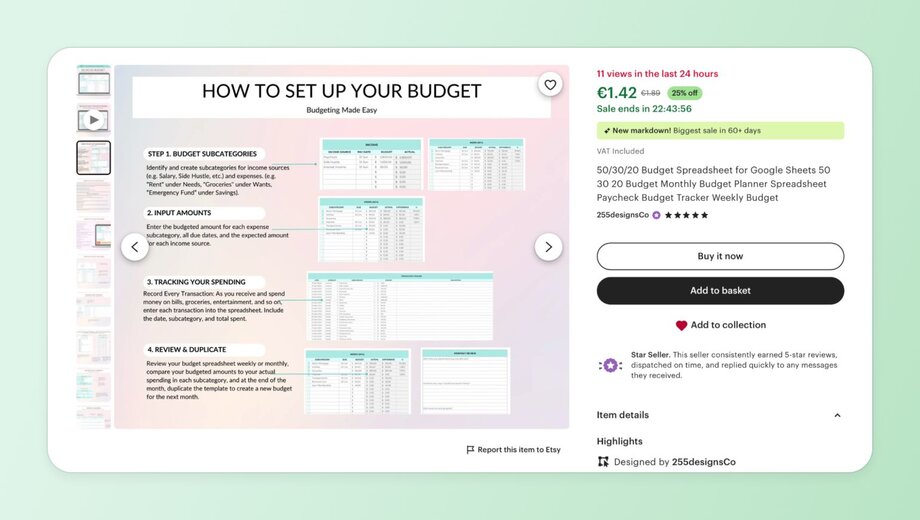
The bottom line? Make it ridiculously easy for your customers to start seeing value right away.
Build in feedback loops
You’re a little biased as the creator of your own product. That’s just how it is. But once you start selling, real feedback will start rolling in, for better or worse.
Most of it will likely be positive, but you’ll also hear some criticism. Maybe someone finds something confusing, or a buyer expected a feature you didn’t include. Try not to take it personally. Instead, use it as one input (of many other considerations) to make your product better.
The easiest way to create a feedback loop? Add your email to the product delivery email or download page with a simple note like, “Drop me a line if you run into any issues with the product.”
Alternatively, if you collect customer emails during checkout, you can also send a quick check-in message a few days after the purchase to ask how things are going and if they need extra help with the product.
Turn buyers into community members
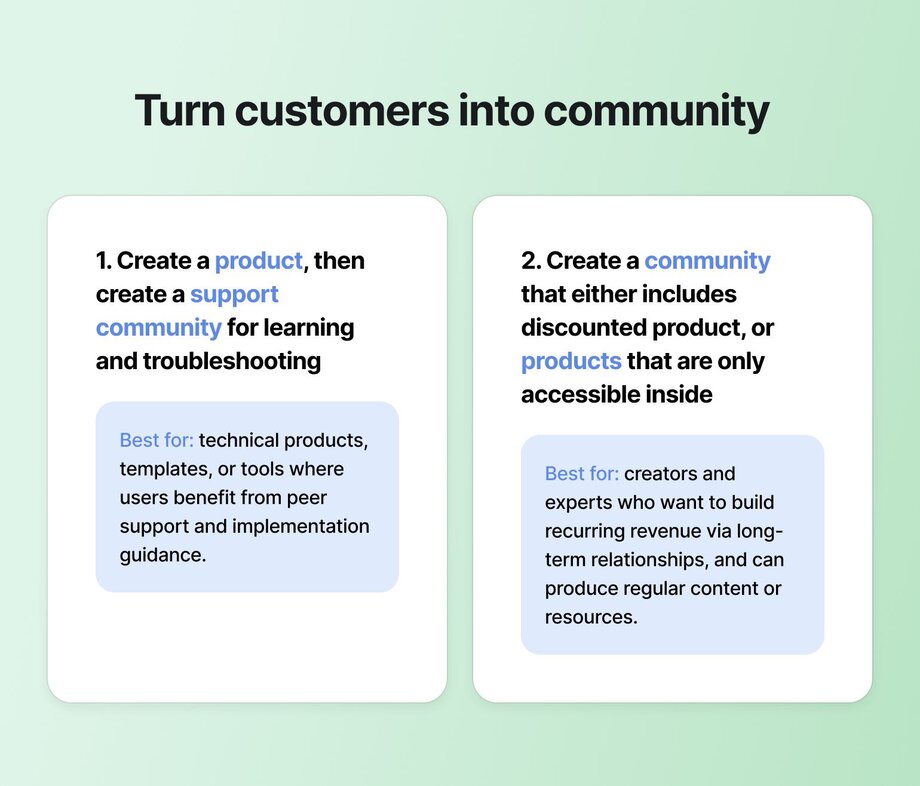
If you want to build a really sustainable digital business—not just rack up one-off sales—the next step is turning customers into a community.
Invite your buyers into a dedicated space where they can ask questions, share their wins, troubleshoot, and connect with others who are using your product. Or flip the model: build the community first, then sell your digital products inside.
Either way, the goal is the same—create a shared space that adds value and creates a relationship beyond the transaction. Platforms like Circle make this easy. You can bring your courses, content, events, and members into one branded space that actually feels like yours.
If you’re building multiple digital products in the same niche—a course, a template pack, a group program—Circle makes it easy to tie them all together. You can offer one-time purchases or subscriptions, drip out lessons, host live workshops, and run everything under your own brand. No duct-taping five different tools. Just one platform for you and your people.
When done right, your community becomes more than a support space—it becomes your most powerful product ecosystem.
Real-world examples of digital products (from Circle creators!)
The Public Health Club – Monthly memberships + digital resources
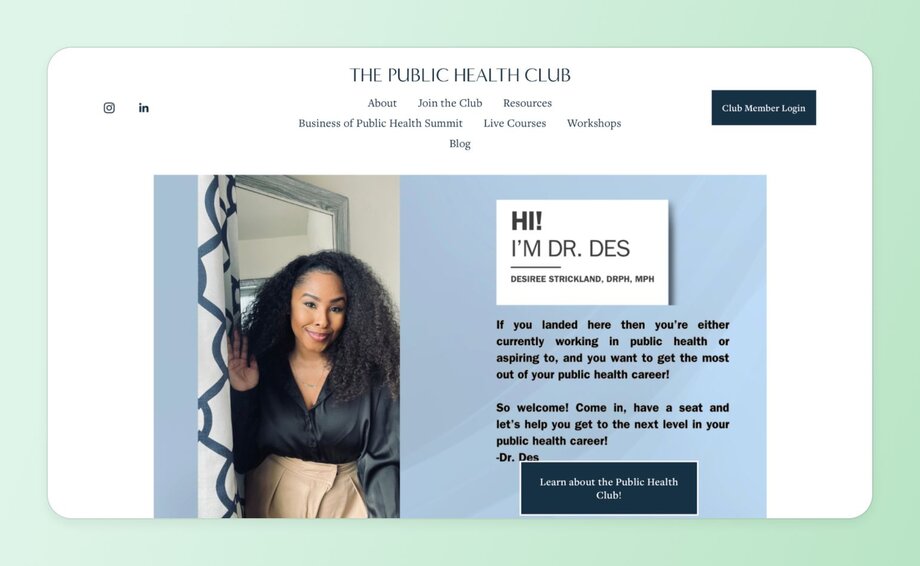
Dr. Des, founder of The Public Health Club, uses Circle as her community platform—but she’s also built a thriving digital product business alongside it. Each month, she releases a brand-new digital resource exclusively for her members, available for free during that month only. Afterward, the resource is added to her online store and sold separately.
This approach has helped her:
- Reduce churn by 5%, as members are incentivized to stay in the community to access valuable resources without having to purchase them separately
- Build a growing suite of digital products to pull from for future offers
- Use each resource as a test case to gather feedback and improve her marketing
Adventure Ready Academy – Fitness & nutrition coaching for adventurous women
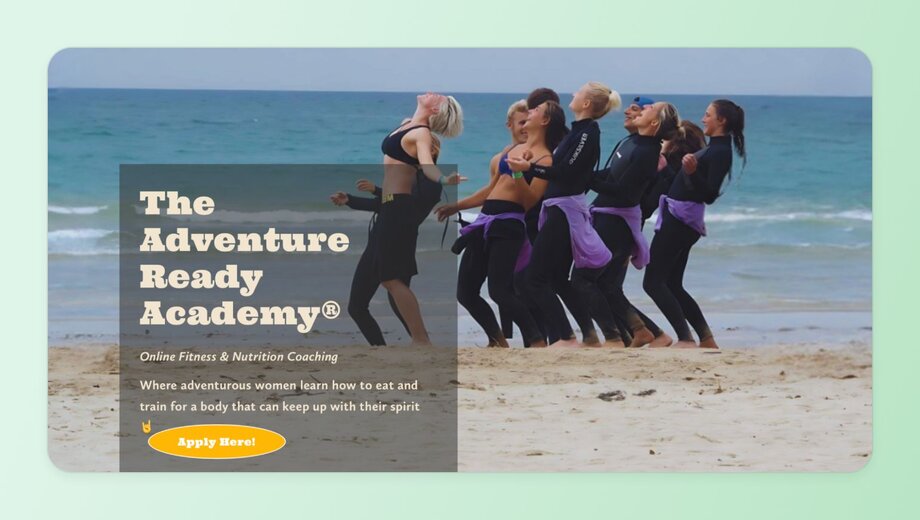
Coach Mac created The Adventure Ready Academy, a 12-month holistic fitness and nutrition program designed specifically for adventurous women who want to build a strong, resilient body that can keep up with their spirit. Through Circle, she delivers a premium experience that includes:
- Structured training programs (like Anti-Fragile Strength)
- Flexible, sustainable nutrition coaching
- A private coaching community with weekly calls and personalized check-ins
- Self-paced learning through the Resilient Body Roadmap
By integrating content, coaching, and community in one branded space, Coach Mac created a high-touch digital product with serious transformation potential—and a pricing model to match.
Outside Shore Music – Online courses that build a community
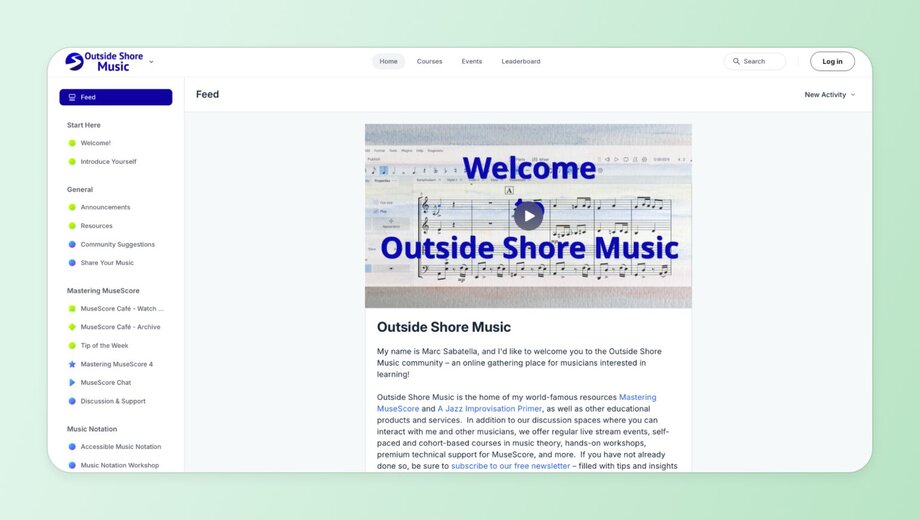
Marc Sabatella, founder of the Outside Shore Music community, offers several digital courses, but his flagship is Mastering MuseScore 4. His strategy? Use in-depth courses to drive community signups.
While the community is where most of the magic happens—peer interaction, Q&A, ongoing support—the courses are what draw people in and demonstrate the value of joining. It’s a great example of how evergreen digital products can feed directly into community growth and member retention.
Emerging digital product trends
The digital product space is evolving—fast.
A few years ago, launching a product was relatively simple. Creators could package a basic PDF, upload it to Gumroad, and with the right visuals and a punchy landing page, sales often followed. But that approach doesn’t work as well today.
The market is more crowded, and audiences have grown more skeptical. Many buyers have experienced products that overpromised and underdelivered, especially those selling the dream of “passive income” with little effort.
This shift in buyer behavior is happening alongside a major leap in creation tools. AI-powered platforms like OpenAI’s GPT-4o image generation and Canva’s AI features now allow creators to design polished, professional-grade products in a matter of hours. The barrier to entry has dropped significantly.
Just because you can create digital products quickly doesn’t mean you should sacrifice quality. Poor-quality products won’t sell—and they definitely won’t help you build a sustainable business or respected brand. Period.
Before you launch, ask yourself:
- Does your product deliver on its promise?
- Will people actually learn or gain something from it?
- Are you making unrealistic claims like “Get rich in a week” when it’s not true?
The digital product space is full of opportunities to move fast, but fast doesn’t mean easy money. Build with integrity, and always focus on delivering real value.
Ready to build a repeatable digital product sales system?
Selling a digital product is exciting. But relying on one-off sales? That’s exhausting. The creators who stick around and whose products are touted as best-of-the-best build systems—onboarding, feedback loops, upsells, and communities that make the next sale easier than the first.
If you’re looking for a hub for your digital products and your community? Welcome home.
Circle brings together your members, discussions, events, courses, and content—all in one place, under your own brand. Plus, you get access to our customer community full of handy resources and over 13,000 community builders on the same journey as you.